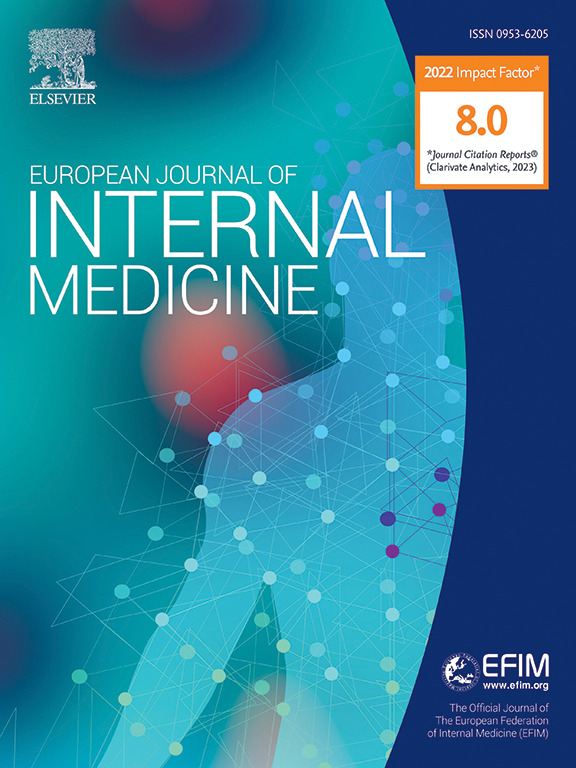Red flags for clinical suspicion of eosinophilic granulomatosis with polyangiitis (EGPA)
IF 5.9
2区 医学
Q1 MEDICINE, GENERAL & INTERNAL
引用次数: 0
Abstract
Background
Eosinophilic granulomatosis with polyangiitis (EGPA), is a rare ANCA-associated systemic vasculitis. Its overlapping features with other vasculitic or eosinophilic diseases, and the wide and heterogeneous range of clinical manifestations, often result in a delay to diagnosis.
Objective
To identify red flags that raise a suspicion of EGPA to prompt diagnostic testing and to present an evidence-based clinical checklist tool for use in routine clinical practice.
Methods
Systematic literature review and expert consensus to identify a list of red flags based on clinical judgement. GRADE applied to generate a strength of recommendation for each red flag and to develop a checklist tool.
Results
86 studies were included. 40 red flags were identified as relevant to raise a suspicion of EGPA and assessed by the experts as being clinically significant. Experts agreed that a diagnosis of EGPA should be considered in a patient aged ≥6 years with a blood eosinophil level >1000 cells/µL if untreated and >500 cells/µL if previously treated with any medication likely to have altered the blood eosinophil count. The presence of asthma and/or nasal polyposis should reinforce a suspicion of EGPA. Red flags of asthma, lung infiltrates, pericarditis, cardiomyopathy, polyneuropathy, biopsy with inflammatory eosinophilic infiltrates, palpable purpura, digital ischaemia and ANCA positivity, usually anti-myeloperoxidase, among others, were identified.
Conclusion
The identification of a comprehensive set of red flags could be used to raise a suspicion of EGPA in patients with eosinophilia, providing clinicians with an evidence-based checklist tool that can be integrated into their practice.
临床怀疑嗜酸性粒细胞肉芽肿伴多血管炎(EGPA)的警示。
背景:嗜酸性粒细胞肉芽肿伴多血管炎(EGPA嗜酸性粒细胞肉芽肿伴多血管炎(EGPA)是一种罕见的ANCA相关性系统性血管炎。它与其他血管炎或嗜酸性粒细胞疾病的特征重叠,临床表现广泛且异质性强,往往导致诊断延误:目的:确定引起对 EGPA 怀疑的红色信号,以促使进行诊断检测,并提出基于证据的临床核对表工具,供常规临床实践使用:方法:系统性文献回顾和专家共识,根据临床判断确定红旗信号列表。结果:共纳入 86 项研究:结果:共纳入 86 项研究。结果:共纳入了 86 项研究,其中 40 项红旗被确定为与怀疑 EGPA 相关,并被专家评估为具有临床意义。专家们一致认为,如果患者年龄≥6 岁,且血液中嗜酸性粒细胞水平>1000 cells/µL(如果未接受治疗),或>500 cells/µL(如果之前接受过任何可能会改变血液中嗜酸性粒细胞数量的药物治疗),则应考虑诊断为 EGPA。哮喘和/或鼻息肉病的存在应加强对 EGPA 的怀疑。此外,还确定了哮喘、肺部浸润、心包炎、心肌病、多发性神经病、活检有炎症性嗜酸性粒细胞浸润、可触及的紫癜、数字缺血和 ANCA 阳性(通常为抗骨髓过氧化物酶)等红旗:结论:识别出一整套红旗可用于怀疑嗜酸性粒细胞增多症患者患有 EGPA,为临床医生提供了一种循证核对表工具,可将其纳入临床实践中。
本文章由计算机程序翻译,如有差异,请以英文原文为准。
求助全文
约1分钟内获得全文
求助全文
来源期刊
CiteScore
9.60
自引率
6.20%
发文量
364
审稿时长
20 days
期刊介绍:
The European Journal of Internal Medicine serves as the official journal of the European Federation of Internal Medicine and is the primary scientific reference for European academic and non-academic internists. It is dedicated to advancing science and practice in internal medicine across Europe. The journal publishes original articles, editorials, reviews, internal medicine flashcards, and other relevant information in the field. Both translational medicine and clinical studies are emphasized. EJIM aspires to be a leading platform for excellent clinical studies, with a focus on enhancing the quality of healthcare in European hospitals.

 求助内容:
求助内容: 应助结果提醒方式:
应助结果提醒方式:


